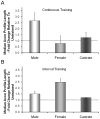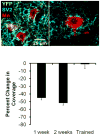Enhancing recovery from peripheral nerve injury using treadmill training
- PMID: 21498059
- PMCID: PMC3137663
- DOI: 10.1016/j.aanat.2011.02.013
Enhancing recovery from peripheral nerve injury using treadmill training
Abstract
Full functional recovery after traumatic peripheral nerve injury is rare. We postulate three reasons for the poor functional outcome measures observed. Axon regeneration is slow and not all axons participate. Significant misdirection of regenerating axons to reinnervate inappropriate targets occurs. Seemingly permanent changes in neural circuitry in the central nervous system are found to accompany axotomy of peripheral axons. Exercise in the form of modest daily treadmill training impacts all three of these areas. Compared to untrained controls, regenerating axons elongate considerably farther in treadmill trained animals and do so via an autocrine/paracrine neurotrophin signaling pathway. This enhancement of axon regeneration takes place without an increase in the amount of misdirection of regenerating axons found without training. The enhancement also occurs in a sex-dependent manner. Slow continuous training is effective only in males, while more intense interval training is effective only in females. In treadmill trained, but not untrained mice the extent of coverage of axotomized motoneurons is maintained, thus preserving important elements of the spinal circuitry.
Copyright © 2011 Elsevier GmbH. All rights reserved.
Figures






Similar articles
-
Sex differences in the effectiveness of treadmill training in enhancing axon regeneration in injured peripheral nerves.Dev Neurobiol. 2012 May;72(5):688-98. doi: 10.1002/dneu.20960. Dev Neurobiol. 2012. PMID: 21805686 Free PMC article.
-
Neurotrophin-4/5 is implicated in the enhancement of axon regeneration produced by treadmill training following peripheral nerve injury.Eur J Neurosci. 2011 Jun;33(12):2265-71. doi: 10.1111/j.1460-9568.2011.07724.x. Epub 2011 May 30. Eur J Neurosci. 2011. PMID: 21623957 Free PMC article.
-
Treadmill training promotes axon regeneration in injured peripheral nerves.Exp Neurol. 2008 Jun;211(2):489-93. doi: 10.1016/j.expneurol.2008.02.013. Epub 2008 Mar 5. Exp Neurol. 2008. PMID: 18420199 Free PMC article.
-
Axon regeneration and exercise-dependent plasticity after spinal cord injury.Ann N Y Acad Sci. 2013 Mar;1279(1):154-63. doi: 10.1111/nyas.12052. Ann N Y Acad Sci. 2013. PMID: 23531013 Free PMC article. Review.
-
Effects of activity-dependent strategies on regeneration and plasticity after peripheral nerve injuries.Ann Anat. 2011 Jul;193(4):347-53. doi: 10.1016/j.aanat.2011.02.012. Epub 2011 Mar 17. Ann Anat. 2011. PMID: 21514121 Review.
Cited by
-
Self-reinnervated muscles lose autogenic length feedback, but intermuscular feedback can recover functional connectivity.J Neurophysiol. 2016 Sep 1;116(3):1055-67. doi: 10.1152/jn.00335.2016. Epub 2016 Jun 15. J Neurophysiol. 2016. PMID: 27306676 Free PMC article.
-
Treadmill training of rats after sciatic nerve graft does not alter accuracy of muscle reinnervation.Front Neurol. 2023 Jan 19;13:1050822. doi: 10.3389/fneur.2022.1050822. eCollection 2022. Front Neurol. 2023. PMID: 36742044 Free PMC article.
-
Presynaptic active zones of mammalian neuromuscular junctions: Nanoarchitecture and selective impairments in aging.Neurosci Res. 2018 Feb;127:78-88. doi: 10.1016/j.neures.2017.11.014. Epub 2017 Dec 6. Neurosci Res. 2018. PMID: 29221906 Free PMC article. Review.
-
Chemogenetic enhancement of functional recovery after a sciatic nerve injury.Eur J Neurosci. 2017 May;45(10):1252-1257. doi: 10.1111/ejn.13550. Epub 2017 Mar 28. Eur J Neurosci. 2017. PMID: 28244163 Free PMC article.
-
Effects of Repeated 20-Hz Electrical Stimulation on Functional Recovery Following Peripheral Nerve Injury.Neurorehabil Neural Repair. 2019 Sep;33(9):775-784. doi: 10.1177/1545968319862563. Epub 2019 Jul 22. Neurorehabil Neural Repair. 2019. PMID: 31328654 Free PMC article.
References
-
- Adlard PA, Cotman CW. Voluntary exercise protects against stress-induced decreases in brain-derived neurotrophic factor protein expression. Neuroscience. 2004;124:985–992. - PubMed
-
- Adlard PA, Perreau VM, Engesser-Cesar C, Cotman CW. The timecourse of induction of brain-derived neurotrophic factor mRNA and protein in the rat hippocampus following voluntary exercise. Neurosci Lett. 2004;363:43–48. - PubMed
-
- American Physiological Society. Resource Book for the Design of Animal Exercise Protocols. American Physiological Society; 2006.
-
- Asensio-Pinilla E, Udina E, Jaramillo J, Navarro X. Electrical stimulation combined with exercise increase axonal regeneration after peripheral nerve injury. Exp Neurol. 2009;219:258–265. - PubMed
Publication types
MeSH terms
Substances
Grants and funding
LinkOut - more resources
Full Text Sources
Medical

